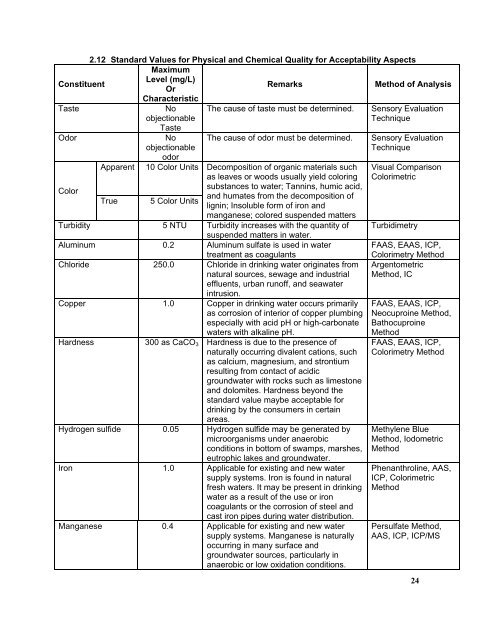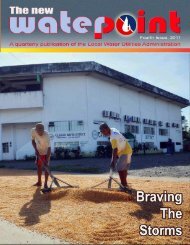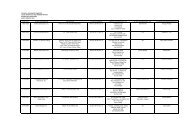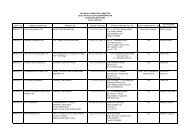Philippine National Standards for Drinking Water - LWUA
Philippine National Standards for Drinking Water - LWUA
Philippine National Standards for Drinking Water - LWUA
You also want an ePaper? Increase the reach of your titles
YUMPU automatically turns print PDFs into web optimized ePapers that Google loves.
2.12 Standard Values <strong>for</strong> Physical and Chemical Quality <strong>for</strong> Acceptability Aspects<br />
Maximum<br />
Constituent<br />
Level (mg/L)<br />
Or<br />
Remarks<br />
Method of Analysis<br />
Characteristic<br />
Taste<br />
No<br />
objectionable<br />
Taste<br />
The cause of taste must be determined. Sensory Evaluation<br />
Technique<br />
Odor<br />
Color<br />
Apparent<br />
True<br />
No<br />
objectionable<br />
odor<br />
10 Color Units<br />
5 Color Units<br />
The cause of odor must be determined.<br />
Decomposition of organic materials such<br />
as leaves or woods usually yield coloring<br />
substances to water; Tannins, humic acid,<br />
and humates from the decomposition of<br />
lignin; Insoluble <strong>for</strong>m of iron and<br />
manganese; colored suspended matters<br />
Turbidity 5 NTU Turbidity increases with the quantity of<br />
suspended matters in water.<br />
Aluminum 0.2 Aluminum sulfate is used in water<br />
treatment as coagulants<br />
Chloride 250.0 Chloride in drinking water originates from<br />
natural sources, sewage and industrial<br />
effluents, urban runoff, and seawater<br />
intrusion.<br />
Copper 1.0 Copper in drinking water occurs primarily<br />
as corrosion of interior of copper plumbing<br />
especially with acid pH or high-carbonate<br />
waters with alkaline pH.<br />
Hardness 300 as CaCO 3 Hardness is due to the presence of<br />
naturally occurring divalent cations, such<br />
as calcium, magnesium, and strontium<br />
resulting from contact of acidic<br />
groundwater with rocks such as limestone<br />
and dolomites. Hardness beyond the<br />
standard value maybe acceptable <strong>for</strong><br />
drinking by the consumers in certain<br />
areas.<br />
Hydrogen sulfide 0.05 Hydrogen sulfide may be generated by<br />
microorganisms under anaerobic<br />
conditions in bottom of swamps, marshes,<br />
eutrophic lakes and groundwater.<br />
Iron 1.0 Applicable <strong>for</strong> existing and new water<br />
supply systems. Iron is found in natural<br />
fresh waters. It may be present in drinking<br />
water as a result of the use or iron<br />
coagulants or the corrosion of steel and<br />
cast iron pipes during water distribution.<br />
Manganese 0.4 Applicable <strong>for</strong> existing and new water<br />
supply systems. Manganese is naturally<br />
occurring in many surface and<br />
groundwater sources, particularly in<br />
anaerobic or low oxidation conditions.<br />
Sensory Evaluation<br />
Technique<br />
Visual Comparison<br />
Colorimetric<br />
Turbidimetry<br />
FAAS, EAAS, ICP,<br />
Colorimetry Method<br />
Argentometric<br />
Method, IC<br />
FAAS, EAAS, ICP,<br />
Neocuproine Method,<br />
Bathocuproine<br />
Method<br />
FAAS, EAAS, ICP,<br />
Colorimetry Method<br />
Methylene Blue<br />
Method, Iodometric<br />
Method<br />
Phenanthroline, AAS,<br />
ICP, Colorimetric<br />
Method<br />
Persulfate Method,<br />
AAS, ICP, ICP/MS<br />
24







